目录
英语从句
英语从句之所以对很多人造成困扰, 主要是因为中文,虽然有和英语对应的表达,但是往往在语句结构上很不一样。
比如,形容词从句的构成方式 ,可以说在中文里 根本不存在
有的资料说 形容词从句,有的说定语从句,有的说关系从句,其实是同一个概念
有一些从句不是并列关系而是包含关系,比如名词从句 > 主语从句 > 限定性从句
英语的句子分三种
- 简单句 不能再拆
- 复合句 不分主次 并列复合句
- 复杂句 主句+从句 主从复合句 (本文的内容就这这个)
比如宾语从句
I saw that the rabbit ate a carrot
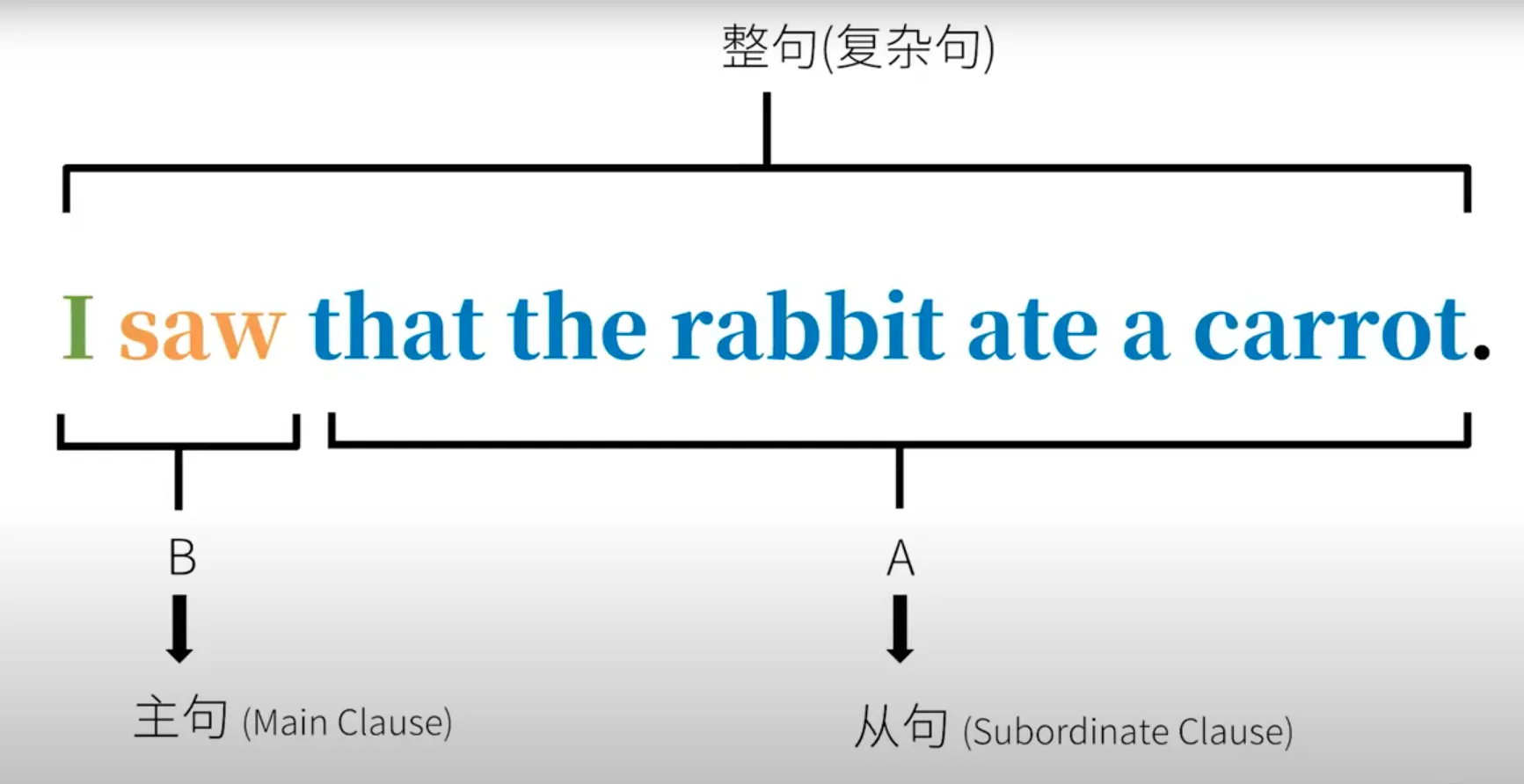
如果按照句子成分进行分类, 除了谓语动词 都可以有从句
- 主语从句
- 宾语从句
- 宾语补语从句
- 表语从句
- 定语从句
- 状语从句
- 同位语从句
如果按照词类(词性)进行分类,可以分为
- 名词性从句(主语从句、 宾语从句、表语从句、
宾语补语从句、同位语从句) - 定语从句(有形容词性质的),也被称作形容词性从句
- 由于定语从句往往会用到一些关系词, 也被称为关系从句
- 状语从句相当于一个大副词,也被称作副词性从句
- 时间副词(状语)从句
- 地点副词(状语)从句
- 条件,原因,方式,比较。。。状语从句
形容词从句
对某个人或事物进行描述, 具有形容词性质的从句,叫做形容词性从句。 因为在句子成分中做定语,也叫定语从句
- 形容词从句的思维方式
- 形容词性从句的构成
- 形容词从句的限定性和非限定性

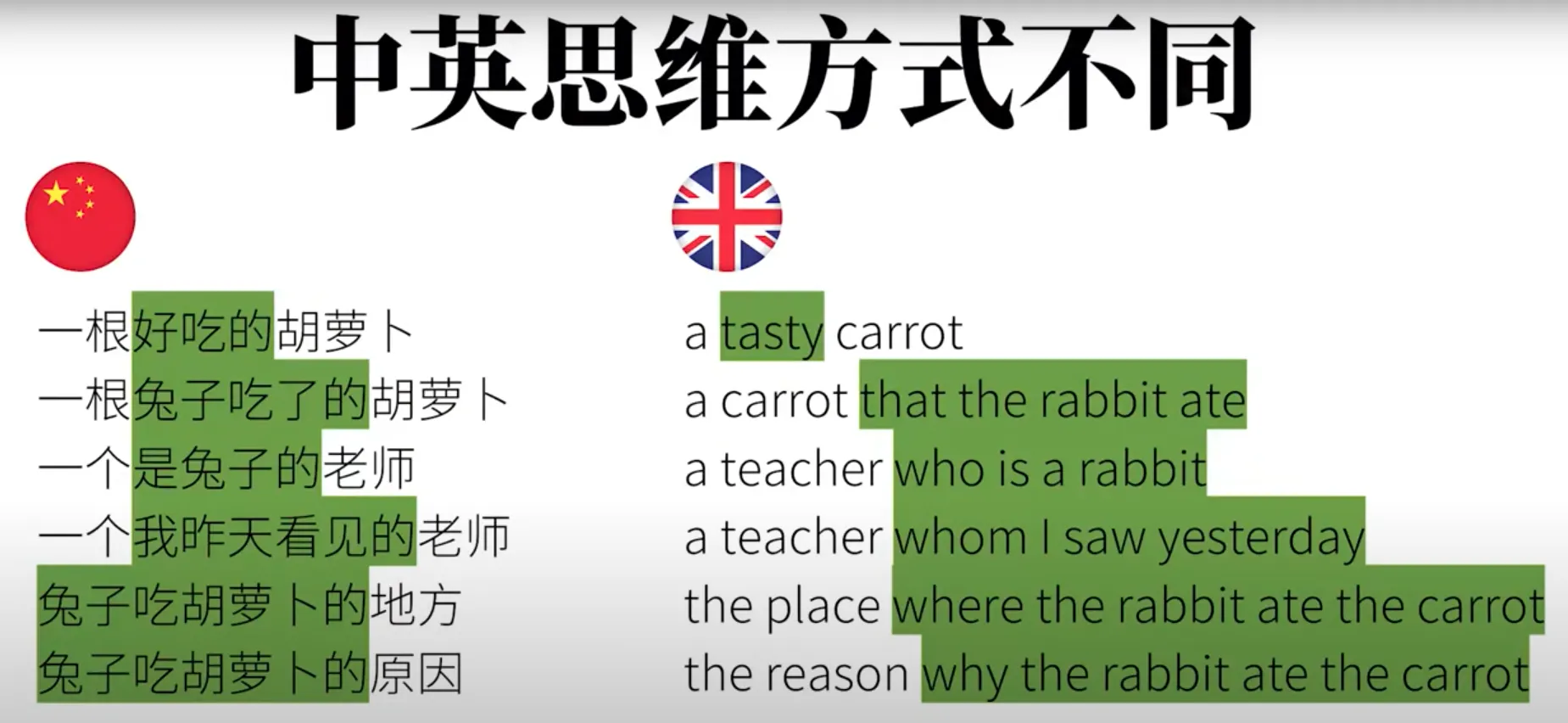
关系词 分为关系代词 和 关系副词
关系代词引导的形容词性从句
来看一些例子
- The rabbit is eating a carrot that I bought
- The teacher who ate a carrot is a rabbit
- The teacher whom I saw yesterday is a rabbit
- The teacher whose favorite food is carrot is a rabbit
- The food which the teacher likes is a rabbit
这里的关系代词之所以是 who whom whose witch 都是为了在他们引导的从句中更加顺畅,因为这些词表达的逻辑关系,实际上是从对应的陈述句中变过来的。而这些从句中除去关系代词在开头做引导词,其他词的语序与对应的陈述的语序是一致的
| 句子 | 充当定语的原本是陈述的句子 | 陈述语句包含关系代词 | 从句(提前关系代词) |
|---|---|---|---|
| The rabbit is eating a carrot that I bought | I bought the carrot | I bought that | that I bought |
| The teacher who ate a carrot is a rabbit | the rabbit ate a carrot | who ate a carrot | who ate a carrot |
| The teacher whom I saw yesterday is a rabbit | I saw the teacher yesterday | I saw whom yesterday | whon I saw yesterday |
| The teacher whose favorite food is carrot is a rabbit | the teacher's favorite food is carrot | whose favourite food is carrot | whose favorite food is carrot |
| The food which the teacher likes is a rabbit | the teacher likes the food | the teacher likes which | which the teacher likes |
which 和 that 的异同
which 和 that 经常可以互换
- The food witch the teacher likes is a carrot
- The food that the teacher likes is a carrot
但区别是
- 如果先行词明确、唯一,没有其他可能时就要用 that
- 而如果很多个同类事物中按限定条件选择,则不一定用that,也可以用which
例子
| - | - |
|---|---|
| 先行词是唯一的: that | The rabbit ate the largest carrot that I've ever seen all the rabbits that ate a carrot the only rabbit that ate a carrot the first rabbit that ate a carrot |
| 先行词多选一 | The rabbit ate a carrot which I bought The rabbit ate a carrot that I bought |
关系副词引导的形容词性从句
- This was the place where the rabbit ate the carrot
- This is the reason why the rabbit ate the carrot
- That was the day when the rabbit ate the carrot for the first Time
关系副词可以转换为关系代词引导的形容词性从句,(关系副词=介词+关系代词)如上述句子可转换为
- This was the place at which the rabbit ate the carrot
- This is the reason for which the rabbit ate the carrot
- That was the day on which the rabbit ate the carrot for the first Time
限定性形容词性从句
The rabbit ate the carrot which was on the table
非限定性形容词从句
The rabbit ate the carrot, which was on the table
这里的witch 等价于 the carrot, 这就变成了非限定形容词从句了
非限定性形容词从句 往往用来做句子的插入语, 比如
The biggest carrot, which the rabbit ate, was on the table
非限定性形容词从句,不一定是补充某个先行词,而是可以指代整句话,比如
The rabbit ate the carrot, which was not surprising
名词性从句
名词性从句 包括主语从句、宾语从句、表语从句、同位语从句、宾语补语从句
主语从句
That the rabbit ate a carrot is obvious
主语从句 就是句子的主语 由从句充当, 其他的该怎么来就怎么来
不确定的信息也可以充当主语从句
| 中 | 英 |
|---|---|
| 兔子是否吃了胡萝卜是明显的 | Whether the rabbit ate the carrot is obvious |
| 兔子哪里吃了胡萝卜是明显的 | Where the rabbit ate the carrot is obvious |
| 兔子什么时候吃了胡萝卜是明显的 | When the rabbit ate the carrot is obvious |
| 兔子怎样吃了胡萝卜是明显的 | How the rabbit ate the carrot is obvious |
| 谁吃了胡萝卜是明显的 | Who ate the carrot is obvious |
| 兔子吃了什么是明显的 | What the rabbit ate is obvious |
上例可以看出主语是由引导词开头的, 这些引导词充当代词或副词,
它们如果出现在问句中,被叫做“疑问代词/疑问副词”
这里用来引导从句,也就叫做从句的“引导词”, 属于“连接代词/连接副词”
从句除去引导词,剩下的词的语序和中文是基本一致的
形式主语
前面的句子把主语从句放在前面,这样带来的问题是, 如果主语从句很长,会导致说了很久,关键信息才出来,比如
That the hungry rabbit had already eaten a carrot for dinner this evening is obvious.
为了避免头重脚轻,就需要改个形式说出来
It is obvious that the hungry rabbit had already eaten a carrot for dinner this evening.
it is obvious就是形式主语,这样的形式主语
再举一些例子
- It is a secret that the rabbit ate a carrot
- It was discussed that the rabbit ate a carrot
- It happened that the rabbit ate a carrot
宾语从句
宾语从句 其实就是从句在整个复杂句中做宾语而已
- 这样的从句可能包含确定信息和不确定信息
- I saw that the rabbit ate a carrot
- I saw Whether the rabbit ate the carrot
- I saw who ate the carrot
- 引导词that的省略 在口语或非正式书面语中,宾语从句的引导词that往往可以省略,比如
- I know (that) the rabbit ate a carrot
只有引导词 that 可以省略,其它引导词 whether/who/what 等不可以省略, 比如
- I know what the rabbit ate
还有一些情况下that 不可以省略 否则句子由歧义或语法错误
I didn't know that the rabbit ate the carrot and that you saw it.
如果同时去掉这两个that,句子与原本的意思就不一致了
I didn't know the rabbit ate the carrot and you saw it.
下面的that 也不能省略,否则有语病
I know, just like you do the rabbit ate the carrot
- 宾语从句的否定
通常 表达某种意见时 用宾语从句
- I think (that) the rabbit is smart
- I believe (that) you will give me some coins
- I expect (that) you will give this video a thumbs-up
在做否定时,否定加在谓语动词前,而非从句中
比如I don't think (that) the rabbit is smart
而不是I think that the rabbit isn't smart
- 大多数情况下,宾语从句的主从时态一致
- I don't think (that) the rabbit is right
- I didn't think (that) the rabbit were right
- I knew (that) the rabbit liked carrots
只有 不变的客观对象才是例外
- I knew (that) the sun rises in the east
这里如果用rise 的过去式rose 就很奇怪
- be + 形容词 + that
- I am sure there's a carrot on the table
- I am happy that where's a carrot on the table
- I am afraid that there's no carrot on the table
表语从句
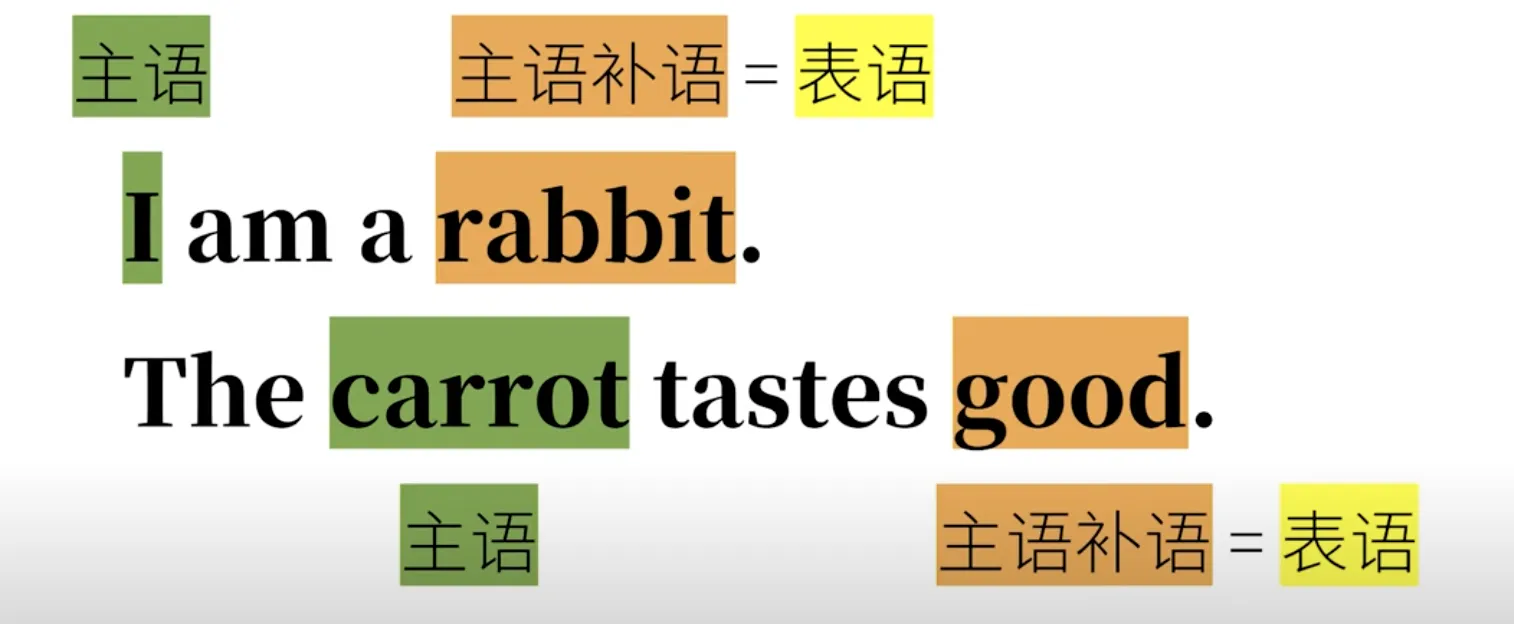
系动词 之前是主语, 之后也是主语补语即表语, 如果用一个句子充当系动词之后的那个表语,就是表语从句
表语从句往往就是把之前的主语从句移动到系动词之后而已
比如,主语从句That the rabbit ate a carrot is a secret 改成表语从句The secret is the rabbit ate a carrot
系动词不一定是be动词,也有可能是 feel, seem, look, taste... 这样的系动词
- It seems that the rabbit is hungry
- It feels that you're not telling the truth
同位语从句

当一个从句来充当同位语时,这个句子就是同位语从句。
- The fact that the rabbit ate the carrot did not suprice me
- The question that whether the rabbot will eat the rabbit is on all our mind
- I have no idea who ate the carrot
- I am sure of the fact that there's a carrot on the table
宾语补语从句
注:宾语补语从句很多语法体系的书都不收录的从句,了解下即可
什么是宾语补语?
前面说5大类的动词中 主语+复杂及物动词+宾语+宾语补语,如果用一句话代替宾语补语,这就是宾语补语从句
相关的动词有 call、make、consider
- You can call me what you like 这里的what you like 就是宾语从句
- My education made me who I am today
虽然把宾语补语从句放在名词里讲,但其实宾语补语从句不见的一定具有名词的性质,也有可能是形容词的性质。
副词从句
可想而知,副词从句在句中起到副词的作用,一般补充说明动词、形容词、副词等。
从句子成分上说,它充当了句子的状语, 所以副词从句也叫 状语从句。
根据用途/意义吧副词从句分类
- 表时间(如:在...之前)
- 表地点(如:在...地方)
- 表条件(如:如果...)
- 表让步(如:虽然...但是...)
- 表方式(如:就好像...)
- 表比较(如:比...)
- 表原因(如:因为...所以)
- 表目的(如:为了...)
- 表结果(如:所以...)
时间状语从句
| - | ||
|---|---|---|
| 在某一事件点之前 before | 在大灰狼串门之前,兔子吃了根胡萝卜 | The rabbit ate a carrot at home before the wolf stopped by Before the wolf stopped by, the rabbit ate a carrot |
| 在某一事件点之中(当时),引导词 when 表“突然” while 时间段 as 同时进行 | 我到家的时候,兔子在吃胡萝卜 当我在做视频的时候兔子在吃胡萝卜 我一边吃胡萝卜一遍做视频 | The rabbit was eating a carrot when I reached home The rabbit was eating a carrot while I was making a video I ate a carrot as I made the video |
| 在某一事件点之后 after | 大灰狼串过门之后,兔子吃了根胡萝卜 | The rabbit ate a carrot after the wolf stopped by |
| 在某一事件点开始算 since | 从大灰狼来串门开始算兔子已经分享了3根胡萝卜了 自从大灰狼串门,兔子就没有停止分享胡萝卜 | The rabbit had shared three carrots since the wolf stopped by The rabbit had not stopped shared carrots since the wolf stopped by |
| 直到之后某一事件点 until | 兔子一直在等,直到大灰狼来串门 | The rabbit waited until the wolf stopped by |
| 一...就 as soon as | 大灰狼一离开,兔子就要吃一个胡萝卜 | The rabbit will eat a carrot as soon as the wolf leaves |
| 下次。。。 the next time | 下次大灰狼来串门时,兔子会分享最大的胡萝卜 | The rabbit will share the biggest carrot the next time the wolf stops by |
地点状语从句
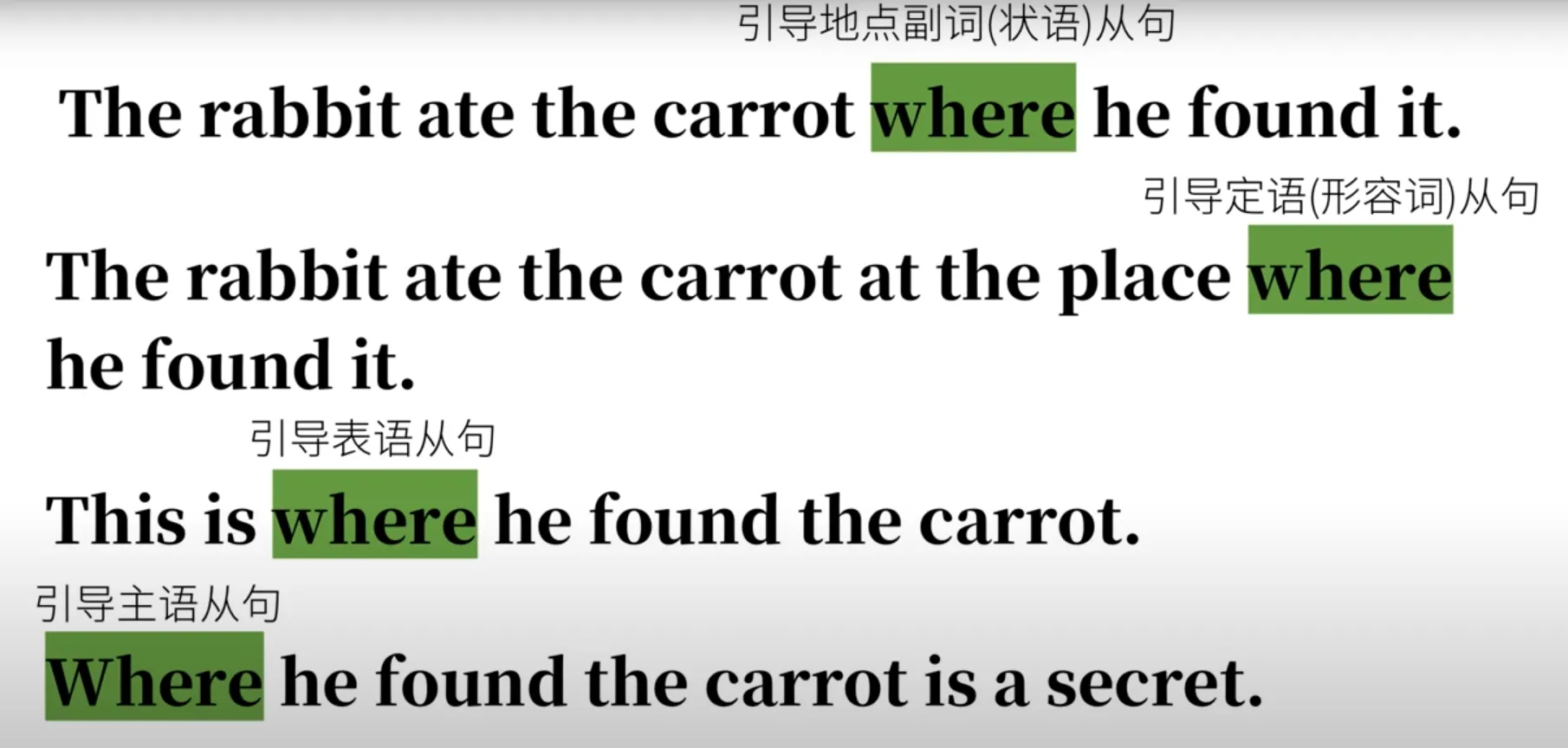
引导词: where + "强调形式", 强调形式有wherever, everywhere,anywhere
| 标题 | |
|---|---|
| 兔子会去能找到胡萝卜的地方 | The rabbit will go where he can find a carrot |
| 兔子会去任何能找到胡萝卜的地方 | The rabbit will go wherever he can find a carrot |
| 兔子走到哪儿都能看到一根胡萝卜 | The rabbit sees a carrot everywhere he goes |
| 兔子可以在任何他喜欢吃的地方吃胡萝卜 | The rabbit can eat a carrot anywhere he likes |
比较状语从句
- 比 谁 更 怎样 英语形容词有比较级
- smart smarter
- big bigger
- beautiful more beautiful
英语语句:比较级
- He is smarter than me
- This carrot is bigger than that one
- She is as beautiful as Snow White
这些句子其实是比较状语从句的省略
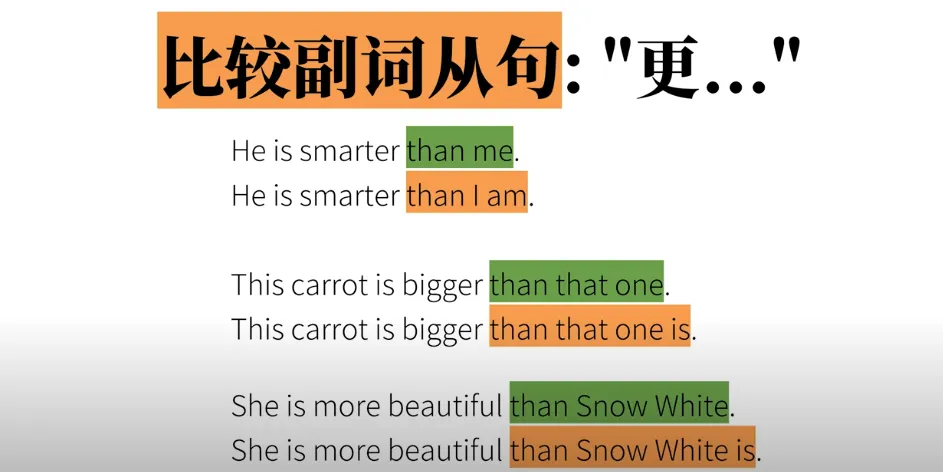
副词从句,用比较的方式对前面的主句进行补充说明。
- 同样的。。。 比较副词从句: “同样的。。。”
He is as smart as me
- 越来越。。。
- The more you practive English, the more fluent you become
- The more coins you give me, the more videos I make.
条件状语从句
条件状语从句 就是平时说的条件句
If the rabbit sees a carrot, he will eat
请注意这是真实条件句,不是虚拟语气!
真实条件句 “主将从现”, 主句用将来时态,从句用现在时态

条件句要比主句在时态上落后一个时间段
- 条件句 一般现在时, 主句一般将来时
- 条件句 一般过去时 主句一般过去将来时
- 条件句 过去完成时 主句过去将来完成时
这个规则同样适用于虚拟语气
条件状语从句的引导词 if unless provided as-long-as in-case
- If you like this video, you will give it a thumbs-up
- If you don't like this video, you will not give it a thumbs-up
- Unless you like this video, you will not give it a thumbs-up
- Provided that my video is excellent, you will give it a thumbs-up
- As long as I make excellent videos, you will remain my follower
- In case you don't understand, please comment blew
方式状语从句
- I feel well as if I just ate a carrot
主句 这是的情况,从句时一个与现实相反的假设
这与虚拟语气有点像,条件句 是一个与现实相反的假设, 主句也是相反的假设
- You speed (so much) money as if you were a millionaire
- Eat the carrot as I do
- Leave the carrot as it is
虽然也描述了某种情况,但是并不是假设,而是某种事实的阐述。 可以把它理解为“正在”发生的某种方式,。
我们其实可以把之前 几个方式状语从句,真的用包含了“方式”这个词的形容词从句来表达(the way),如
- You speed money the way (in which) millionaires do.
- Eat the carrot the way (in which) as I do
让步状语从句
让步状语从句 与 条件状语从句、方式状语从句 有相同的地方, 都是 阐述某种情况,做出某种假设,但接下来会更进一步,做出一个“相反/相对”的阐述, 最常见的是 “即使/就算。。。也。。。”
- Even if I see a carrot, I will not eat it.
让步的情况不一定是假设 也可能是事实
- Although I see a carrot, I will not eat it
这里的although 也可以用though / even though 替代
no matter + 疑问词
- No matter what happens, I will not eat the carrot
- No matter who orders me, I will not eat the carrot
- No matter how hungry I am, I will not eat the carrot
No matter 也可以用 Regardless 取代
- Regardless of what kind of video I make, you will give me a thumbs-up.
原因状语从句
原因状语从句、目的状语从句、结果状语从句的共同点是 都是表达了某种因果, 即 A 导致 B 这样的情况
先来看原因状语从句
- The rabbit ate the carrot because he was hungry
这里because 构成一个复杂句, so(连词)构成一个复合句
- The rabbit was hungry, so he ate the carrot
除了because, since和 as 也可以构成原因状语从句。
- since you are hungry, you can eat the carrot
- As you were not here, we ate the carrot without you
既然because、 since和 as 都能构成原因状语从句,三者的区别是什么?
有两大区别, 第一从因果或 说话语气的程度上说, because > since > as
- Because this video is excellent, you should give it a thumbs-up
- Since all my videos are excellent, you should give it a thumbs-up 众所周知
- As I have thick skin, I'm begging you for a thumbs-up 显而易见的事实
第二大区别是语序
- because引导的从句在主句前后都可以
- since和as引导的从句一般只能放在主句之前
目的状语从句
目的状语从句也有一定的因果关系,只不过是使用目的的方式说出来
因为要达到目的A(从句),所以做了B(主句)
- In order that I could finish the video in time, I pulled an all-nighter
- I pulled an all-nighter so that I could finish the video in time
但是 so that 不能放在句首
目的状语从句一般使用情态动词 can, could, may, might, should, would等
Q: 比较 so..., so that..., so... that... 的区别
so...与前句是并列关系, 这里是复合句so that ...充当的是副词,引导的是目的状语从句so... that......因此...
结果状语从句
- I ate a lot of carrots for lunch so that I wasn't hungry at all in the afternoon
- The temperature was low so that the lake froze
也可以用so ... that... 这个结构
- I ate a lot of carrots form lunch so that I wasn't hungry at all in the afternoon
- I ate so many carrots for lunch that I felt sick afterwards
相似的还有 such... that... 不过 such后要接名词而不是形容词
- It was such a tasty carrot that I ate it all once
- It was so tasty a carrot that I ate it at once
本文作者:郭郭同学
本文链接:
版权声明:本博客所有文章除特别声明外,均采用 BY-NC-SA 许可协议。转载请注明出处!